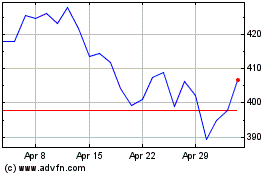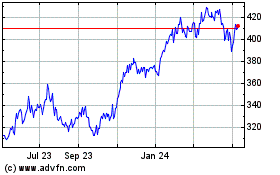By Nathan Olivarez-Giles
If you have a computer running Windows 7 or 8, mark July 30 on
your calendar. That's the day that upgrading your PC to Windows 10
will no longer be free. Once the operating system passes its
one-year anniversary, Microsoft Corp. will start charging $120 to
move over to Windows 10.
When Microsoft first released Windows 10 a year ago, it said the
free upgrade for Windows 7 and Windows 8 users would last a year. (
Windows XP users already pay at least $120 to upgrade.) The limited
time offer was a bid to get as many people on to Windows 10, as
quickly as possible. So far, Microsoft's ploy appears to be
working: 300 million active devices, old and new PCs, are now
running on Windows 10, Microsoft said Thursday in a blog post.
Not only does Windows 10 have the fastest adoption rate of any
version of Windows, but WSJ Personal Tech columnist Geoffrey A.
Fowler found Windows 10 to be a worthwhile upgrade for the majority
of people currently using an older version of Windows.
But with PC sales continuing to hit new lows, the pressure is on
Microsoft to start charging for Windows 10 from a PC industry that
has so far missed out on any PC sales bump it's seen in the past
when new versions of Windows arrive.
So what does all this mean for you, as a Windows user?
You can still save some money
If you think you might upgrade but have put it off because you
didn't want to be an early adopter, it's time to go for it. Waiting
-- and then paying for Windows 10 Home ($120) -- isn't worth it.
Start by visiting the Windows Update website and check to see if
your PC is compatible with Windows 10. If it is, Microsoft will
walk you through the upgrade.
Before you upgrade, make sure you back up your important files,
photos and other media on an external hard drive and, if possible,
in a cloud service too. Also check out our guide to the risks and
concerns of upgrading to Windows 10 if you have lingering
questions.
Your old apps will stick with you, mostly
Most of your Windows 7 and 8 apps should run on Windows 10, and
your media should be in place after you upgrade. Some, like Windows
Media Center (an older Windows app for watching movies and
listening to music on your TV), won't make the transition.
Windows 10 is safer
If you have an older model with Windows 7 or 8, you really
should upgrade. Not keeping up with software updates can make any
devices more vulnerable to hackers. If you don't want to upgrade,
be mindful of how much longer Microsoft will offer security updates
for your operating system of choice.
Microsoft stopped issuing security updates for Windows XP in
2014, and it will abandon Windows Vista in 2017. It is going to end
all support for Windows 7 in 2020, and Windows 8 in 2023. As of
now, Microsoft said it plans to support Windows 10 through
2025.
Don't forget to dust off your old PC, too
If you have a mothballed PC that you were planning to one day
hand down or sell, get it out and upgrade it before July 30. Your
old PC with Windows 10 will be more useful and valuable to whomever
gets it next.
Make sure your next PC runs Windows 10
If you're thinking of buying a PC, be sure it comes with Windows
10. Dell, Lenovo, HP, Acer and others all still sell new PCs
running Windows 7 and Windows 8 -- often with a "free Windows 10
upgrade" marketing pitch -- so if you do buy one of those, hurry up
and do the upgrade.
Consider dumping Windows
If you don't want to pay for future operating system updates,
you have two choices: move your old PC over to Windows 10 in the
next few weeks, or move away from Windows altogether. Apple Inc.
hasn't charged its users for an update to its OS X operating system
since charging $20 for OS X 10.8 Mountain Lion more than three
years ago. Alphabet Inc.'s Chromebooks (which with only the ability
to access web apps and web pages are admittedly less capable than a
PC and Mac) don't make you pay for software updates either.
Don't buy a Windows 10 phone, for now
Windows 10 is the first Microsoft operating system built to run
on laptops, desktops, tablets, the Xbox gaming console and
smartphones. But right now Windows 10 phones don't live up to their
own potential -- and can't keep up with the competition,
either.
While Windows 10 has been a PC success, it has been a dud on
phones to date. Microsoft's share of the mobile operating system
market was down to 1.1% by the end of last year, according to the
Gartner research firm. These days, even Microsoft is making cool
new apps and mobile features for the iPhone instead of its own
Windows 10 mobile phones.
Microsoft needs to win over developers who can build software
titles that will help the company compete both in the
smartphone-dominant era and to gear up for the augmented- or
virtual-reality worlds that could be next. The company wants to
leverage its hundreds of millions of Windows 10 PC users to
convince key developers to make killer apps -- such as Snapchat --
that can run on smartphones running Windows 10, as well as
desktops. It's an uphill battle.
Write to Nathan Olivarez-Giles at
Nathan.Olivarez-giles@wsj.com
(END) Dow Jones Newswires
May 05, 2016 18:07 ET (22:07 GMT)
Copyright (c) 2016 Dow Jones & Company, Inc.
Microsoft (NASDAQ:MSFT)
Historical Stock Chart
From Mar 2024 to Apr 2024

Microsoft (NASDAQ:MSFT)
Historical Stock Chart
From Apr 2023 to Apr 2024
